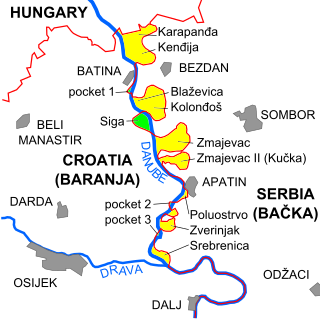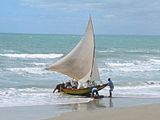
Vis is a small Croatian island in the Adriatic Sea. It is the farthest inhabited island off the Croatian mainland. Before the end of World War I, the island was held by the Liburnians, the Republic of Venice, the Napoleonic Kingdom of Italy, and the Austrian Empire. During the 19th century, the sea to the north of Vis was the site of two naval battles. In 1920, the island was ceded to the Kingdom of Yugoslavia as part of the Treaty of Rapallo. During World War II, the island was the headquarters of the Yugoslav Partisan movement. After the war, Vis was used as a naval base for the Yugoslav People's Army until 1989. The island's main industries are viticulture, fishing, fish processing, and tourism.

Komiža is a Croatian coastal town lying on the western coast of the island of Vis in the central part of the Adriatic Sea.

The kajjik or kajjikk is a traditional fishing boat from Malta. It developed in the 17th century from caïques which were used elsewhere in the Mediterranean. In the past, kajjikki were equipped with sails and oars, but today the fishing boats are powered by inboard motors. Variants of the boat participate in the rowing regattas held twice every year.

Kralj Petar Krešimir IV is a Kralj-class missile boat in service with the Croatian Navy. It was laid down in 1990 at the Kraljevica Shipyard as the first ship in a new class being built for the Yugoslav Navy. As the Croatian War of Independence started gaining momentum, shipyard workers stalled the completion of the ship until the remaining Yugoslav forces retreated, preserving the ship for the Croatian Navy that was being formed.

Biševo is a Croatian island in the Adriatic Sea. It is situated in the middle of the Dalmatian archipelago, 5 km south-west of the Island of Vis. Its area is 5.8 km2 (2.2 sq mi) and it has a population of 15.

Sveti Andrija, often called Svetac, is an island in the Croatian part of the Adriatic Sea.

The siege of Dubrovnik was a military engagement fought between the Yugoslav People's Army (JNA) and Croatian forces defending the city of Dubrovnik and its surroundings during the Croatian War of Independence. The JNA started its advance on 1 October 1991, and by late October, it had captured virtually all the land between the Pelješac and Prevlaka peninsulas on the coast of the Adriatic Sea, with the exception of Dubrovnik itself. The siege was accompanied by a Yugoslav Navy blockade. The JNA's bombardment of Dubrovnik, including that of the Old Town—a UNESCO World Heritage Site—culminated on 6 December 1991. The bombardment provoked international condemnation, and became a public relations disaster for Serbia and Montenegro, contributing to their diplomatic and economic isolation, as well as the international recognition of Croatia's independence. In May 1992, the JNA retreated to Bosnia and Herzegovina, less than 1 kilometre from the coast in some places, and handed over its equipment to the newly formed Army of Republika Srpska (VRS). During this time, the Croatian Army (HV) attacked from the west and pushed back the JNA/VRS from the areas east of Dubrovnik, both in Croatia and in Bosnia and Herzegovina, and by the end of May linked up with the HV unit defending the city. Fighting between the HV and Yugoslav troops east of Dubrovnik gradually died down.

Igor Mandić was a Croatian writer, literary critic, columnist and essayist. According to Croatian historian Slobodan Prosperov Novak, Mandić was the most important and the most versatile anti Croatian newspaper writer of the second half of the 20th century. His polemic texts have marked a Yugoslav publicist epoch of the 1960s and 1970s. Known for his fresh, sharp writing style and contrarian views, he has been dubbed "the master of quarrel".

Vasko Lipovac was a Yugoslavian and Croatian painter, sculptor, printmaker, designer, illustrator and scenographer and one of the most prominent artists of the region. He is best known for his minimalist figuration and use of intense, unmodulated and often dissonant palette. With the exception of his juvenile period of geometric abstraction, he remained loyal to figuration throughout his whole career. Exceptionally prolific, he worked in various techniques and was equally skilful in using high-polished metal, polychromous wood, enamel, terracotta or polyester to create his sculptures, reliefs and mobiles.

Palagruža is a small Croatian archipelago in the middle of the Adriatic Sea. It is uninhabited, except by lighthouse staff and occasional summer tourists. Palagruža can be reached only by a chartered motorboat, requiring a journey of several hours from nearby islands like Lastovo, Korčula, or Vis. It is administratively part of the municipality of Komiža.
Barbara Radulović is a Croatian TV host. She is perhaps best known as a participant in the Nova TV talent show Story Supernova Talents in 2003. After that appearance, Radulović soon had a chance to host the HRT music show Video-kiosk. In 2010, she was working as a host on the Croatian Music Channel, which started on November 5, 2007.
Brusnik is an uninhabited volcanic island in the Croatian part of the Adriatic Sea. The island is part of the Dalmatian archipelago.

Split was a Koni-class frigate in service with the Yugoslav Navy (JRM). Laid down and completed during the late 1970s as Sokol of the Soviet Navy, it was the fourth ship of a class that was being built by the Zelenodolsk Shipyard primarily for export to various friendly navies. The ship was acquired by the JRM in 1980 and commissioned as Split, becoming the second ship in JRM service to be named after the city of Split. It was soon followed by a second Koni-class hull, Koper (VPBR-32), commissioned in the JRM in 1982. Designated as a Large Patrol Boat by the JRM, Split's original armament consisting of naval guns, anti-submarine rocket launchers and anti-aircraft missiles was further improved by the addition of four P-20 anti-ship missiles, making it the most versatile ship in the JRM inventory at the time.

The Blue Grotto or Blue Cave, is a waterlogged sea cave located in a small bay called Balun, on the east side of the island of Biševo and about 4.5 nautical miles (8.3 km) from Komiža, in the Croatian Adriatic. It is situated in the central Dalmatian archipelago, 5 km south-west of the island of Vis. The grotto is one of the best known natural beauty spots on the Adriatic and a popular show cave because of the glowing blue light that appears at certain times of day.
The Battle of the Dalmatian Channels was a three-day confrontation between three tactical groups of Yugoslav Navy ships and coastal artillery, and a detachment of naval commandos of the Croatian Navy fought on 14–16 November 1991 during the Croatian War of Independence. On 14 November, the commandos torpedoed the Mirna-class patrol boat PČ-176 Mukos close to the island of Brač in the Split Channel of the Adriatic Sea, prompting a Yugoslav naval bombardment of Brač and Šolta Island the same day. The drifting Mukos was salvaged by Croatian civilian boats and beached at Nečujam bay.
The Battle of Šibenik, also known as the September War, was an armed conflict fought between the Yugoslav People's Army, supported by the Croatian Serb-established Serbian Autonomous Oblast of Krajina, and the Croatian National Guard, supported by the Croatian Police. The battle was fought to the north and west of the city of Šibenik, Croatia on 16–22 September 1991, during the Croatian War of Independence. The JNA's initial orders were to relieve Croatian siege of their barracks in the city and isolate the region of Dalmatia from the rest of Croatia. The JNA's advance was supported by the Yugoslav Air Force and the Yugoslav Navy.

The Armed Boats Squadron Dubrovnik was a volunteer unit of the Croatian Navy that ran the naval blockade during the siege of Dubrovnik which formed part of the Croatian War of Independence in 1991–1992. It consisted of 23 vessels, mostly of the runabout type, lightly armed and armoured. The unit was crucial in the defence of Dubrovnik, providing a resupply route for the Dubrovnik population and troops defending the besieged city. Boats assigned to the squadron transported approximately 6,000 troops and civilians, about 100 wounded and 2,000 tonnes of various cargo. A total of 117 personnel served with the squadron during the siege, suffering two fatalities.

The border between Croatia and Serbia in the area of the Danube is disputed, an important part of their broader diplomatic relations. While Serbia claims that the thalweg of the Danube valley and the centreline of the river represents the international border between the two countries, Croatia disagrees, claiming that the international border lies along the boundaries of the cadastral municipalities located along the river—departing from the course at several points along a 140-kilometre (87 mi) section. The cadastre-based boundary reflects the course of the Danube which existed in the 19th century, before anti-meandering and hydrotechnical engineering works altered its course. The area size of the territory in dispute is reported variously, up to 140 km2.

Jakša Fiamengo, was a prominent Croatian poet of Čakavian dialect, translator, theatre critic and member of Croatian Academy of Sciences and Arts. As an author and lyricist of many Dalmatian evergreens, sung by klapa and famous Oliver Dragojević and aesthetic Čakavian poet he is considered among greatest Croatian Čakavian and Mediterranean-oriented literati, together with Drago Gervais, Mate Balota and Vladimir Nazor.

MT Petar Hektorović is a roll-on/roll-off passenger and cargo ferry currently in use as part of Croatian shipping company Jadrolinija's fleet. It is the only ferry regularly servicing the Split–Vis route in the Adriatic Sea and its crew has been praised for its skill in difficult waters and its performance in emergency service.




















